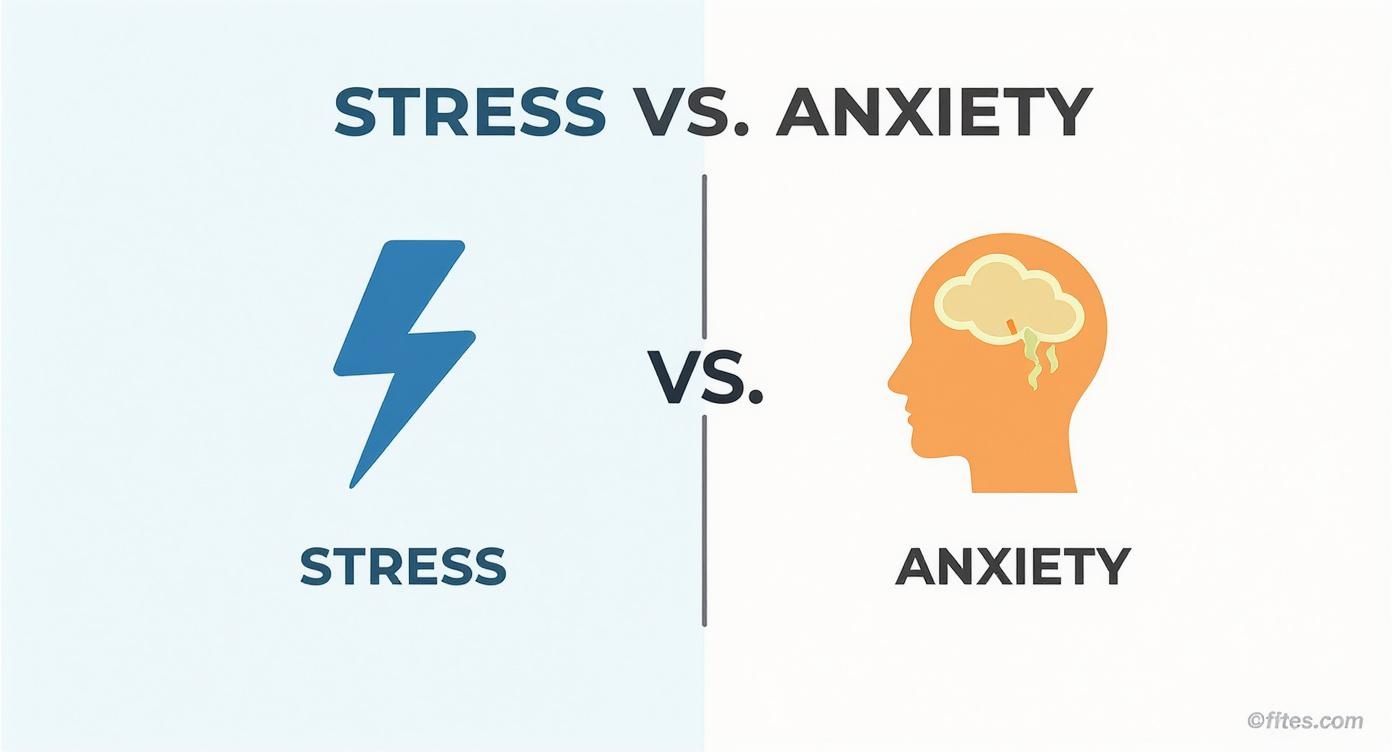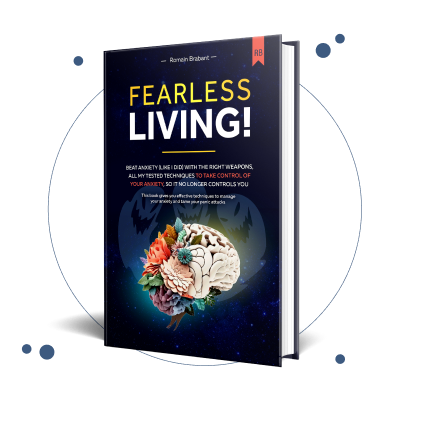
It’s a common mix-up. People often use the words stress and anxiety like they’re the same thing, but they’re not. Think of it this way: stress is usually a reaction to something happening outside of you—a looming project deadline, a tough conversation, or even just a long line at the grocery store.
Anxiety, on the other hand, is what happens inside you. It's an internal response that can stick around long after the external pressure is gone, fueled by persistent, excessive worries about what might happen next.
Understanding the Core Difference Between Anxiety and Stress
Getting a handle on this distinction is the first real step toward taking back control of your mental well-being. While they can feel incredibly similar in the moment, their origins, focus, and how long they last are what truly set them apart. Pinpointing what you're actually feeling is key, because once you understand the enemy, you can begin the journey to healing.
It's also important to recognize that while stress is a universal human experience, anxiety can evolve into a diagnosable condition. Globally, anxiety disorders affect roughly 4.4% of the population—that's about 301 million people. This number has been on the rise, but it also means you are not alone, and there are proven paths to recovery.
Quick Guide Stress vs Anxiety at a Glance
For a quick breakdown, this table cuts through the noise and lays out the core differences side-by-side.
| Characteristic | Stress | Anxiety |
|---|---|---|
| Primary Cause | An external trigger (e.g., work pressure, life event) | An internal reaction to stress or perceived future threats |
| Duration | Usually short-term; ends when the trigger is resolved | Can be long-term and persistent, even without a clear trigger |
| Focus | Reaction to a current, identifiable threat or situation | Worry about future events, potential problems, or "what-ifs" |
| Nature | A response to a specific demand or challenge | A more generalized state of apprehension and unease |
Ultimately, it comes down to asking yourself: Am I reacting to something happening right now, or am I stuck in a loop of dread about what could happen? Exploring the common causes of anxiety can shed more light on why these feelings might be lingering. Once you have that clarity, you can move from feeling confused to taking hopeful, meaningful action.
How Your Body and Mind Respond Differently
To really get the difference between anxiety and stress, you have to look at the unique footprint each one leaves on your body and mind. They can both make you feel tense and overwhelmed, sure, but the why behind those feelings is worlds apart. Nailing this difference is the first real step toward finding lasting relief and realizing that healing is possible.
Stress is your body’s immediate, short-term reaction to a specific challenge you're facing right now. Think of it as your internal alarm system, designed to help you handle a perceived threat. When you’re staring down a tight deadline, for example, your body floods with hormones like adrenaline and cortisol. This is the classic fight-or-flight response kicking in.
Your heart pounds, your muscles get tight, and your focus becomes laser-sharp. These physical changes are all about helping you perform under pressure. Once the presentation is over or the deadline is met, your body's systems usually chill out and return to normal. The response is intense, but it's temporary and directly tied to that external event.
The Anxious Mind's Inner World
Anxiety, though, plays by a different set of rules. It’s an internal state of unease that can stick around long after a stressful situation is over—or even show up with no clear trigger at all. While stress is a reaction to a present danger, anxiety is often a preoccupation with a future threat, one that might not even be real.
This is where the mental game really changes. Someone dealing with anxiety doesn't just worry about a single presentation; they get trapped in a relentless cycle of “what if” scenarios. This pattern is known as catastrophizing—imagining the absolute worst possible outcome and feeling like it's practically guaranteed to happen.
The crucial difference lies in this persistence. Stress is a sprint, a burst of energy to overcome a hurdle. Anxiety is a marathon of worry, often run with no finish line in sight. Recognizing this pattern is empowering—it helps you see that you're not just 'stressed out,' but dealing with something that requires a different approach, one that leads to healing.
From A Moment of Stress to Lasting Anxiety
Let’s go back to that big work presentation to see this in action.
- A Stress Response: You feel the pressure building before the event. Your palms might get sweaty and your heart races right before you speak. But afterward? A huge wave of relief washes over you, and the physical symptoms vanish.
- An Anxiety Response: Weeks before the presentation, you’re already losing sleep over it. You fixate on every single thing that could go wrong. After it’s over, the relief is fleeting because your worry just latches onto the next future event.
Getting a handle on the mechanics of your body’s alarm system is a powerful step. You can learn more about this in our detailed fight-or-flight response guide. When you learn to spot the difference between these responses in your own life, you open the door to healing. You can finally start addressing the root of the worry itself, paving the way for a calmer mind.
Decoding Overlapping Symptoms
It’s easy to get lost in the fog when you’re dealing with things like irritability, a tense body, and sleepless nights. One of the main reasons people ask, "is anxiety stress the same?" is because, on the surface, many of the signs look and feel identical. Understanding this common ground is the first step, but learning to spot the subtle distinctions is where you really start to reclaim your power.
The secret to telling them apart isn’t just in what you feel, but in the context surrounding that feeling. Things like how long it lasts, how intense it is, and whether there's an obvious cause can offer huge clues. This kind of self-awareness is more than just an intellectual exercise; it's a critical step on the path to healing, giving you the clarity needed to choose the right coping strategies.
This concept map breaks down the core elements of stress and anxiety, visualizing their different pathways.

As the visual shows, stress is usually a direct reaction to a trigger, while anxiety is a more persistent, internal state that can linger long after the trigger is gone.
How to Tell Similar Symptoms Apart
Let’s dig into the nuance here. If you’re struggling with concentration, is it because of a specific, high-pressure project at work (a classic stressor)? Or is it a constant state of mental fog that makes it hard to focus on anything at all? The first points to stress; the second is more characteristic of anxiety.
This distinction is actually a hopeful one. When you can pinpoint the source and nature of your feelings, you can address them far more effectively. It’s the difference between putting out a small, contained fire and trying to navigate through a persistent, smoky haze.
The goal isn’t to eliminate every symptom overnight, but to become an expert detective of your own inner world. Recognizing a pattern is the first step toward changing it, and this knowledge empowers you to move from feeling overwhelmed to taking control.
Here’s a detailed comparison table to help you identify what you might be experiencing. Notice how the exact same symptom can show up in very different ways.
Comparing Overlapping Symptoms of Stress and Anxiety
This table breaks down some of the most common shared symptoms, exploring how they tend to manifest differently depending on whether you're dealing with stress or anxiety.
| Shared Symptom | How It Manifests in Stress | How It Manifests in Anxiety |
|---|---|---|
| Irritability | Often directed at the source of stress. You might snap at a coworker during a tough week but feel fine once the pressure is off. | Tends to be a more generalized, free-floating feeling of being on edge with everyone, often for no clear reason. |
| Sleep Issues | Usually trouble falling asleep because your mind is racing about specific problems (e.g., a deadline or a big decision). | Can include trouble falling asleep, staying asleep, or waking up feeling un-rested, fueled by a general sense of dread or worry. |
| Muscle Tension | Typically localized in the neck, shoulders, and back, directly related to a current stressor. It often subsides when you relax. | Can feel more constant and widespread throughout the body, as if you’re always braced for something bad to happen. |
| Difficulty Concentrating | Your focus is hijacked by a specific worry or task list. Once the stressor is handled, your concentration returns. | Feels like a persistent mental fog that makes it hard to focus on anything, even enjoyable activities. |
| Fatigue | A feeling of being mentally or physically drained from dealing with demanding situations. Rest usually helps. | An emotional and physical exhaustion that feels deep-seated and chronic, often not relieved by a good night's sleep. |
Understanding these subtleties is a game-changer. For example, stress might cause you to snap at someone during a tough week, while anxiety could make you feel constantly on edge with everyone for no apparent reason. This kind of insight paves the way for a panic-free life, as you learn to respond to what’s truly happening instead of reacting to a confusing blend of feelings. You have the ability to heal, and it starts right here, with understanding.
Actionable Strategies for Relief and Healing
Knowing the difference between stress and anxiety is a huge first step, but this is where the real work—and your journey toward peace—truly begins. Moving from understanding to action is how you take back the driver's seat. The strategies that follow aren't magic wands, but they are powerful, practical tools designed to give you tangible hope that things can get better.

It all starts with handling stress in the moment, stopping it from escalating into that familiar, lingering anxiety. When you feel that wave of overwhelm start to build, your body desperately needs a signal that you're safe. That's where grounding techniques come in. They are incredibly effective.
Techniques for Immediate Stress Relief
When stress hits, your mind might be ten steps ahead, catastrophizing about the future. But your body? It's always right here, right now. Use it as your anchor.
- The 5-4-3-2-1 Grounding Method: This pulls you out of your head and into your environment. Look around and name five things you can see, four things you can touch, three things you can hear, two things you can smell, and one thing you can taste.
- Deep Breathing: A slow, deep breath is the fastest way to hit the brakes on your body's alarm system. Inhale slowly for a count of four, hold it for four, and then exhale for a long, slow count of six. This little trick activates your parasympathetic nervous system, basically telling your body, "It's okay, we can relax now." For a deeper dive, check out our guide to breathing exercises for anxiety.
- Mindful Movement: Even a few gentle stretches or a quick walk around the block can release a surprising amount of physical tension. Pay attention to the feeling of your feet hitting the pavement or the sensation of your muscles loosening up.
These simple practices break the stress cycle before it gains momentum. They create just enough space for you to think clearly instead of just reacting on autopilot.
Long-Term Approaches for Healing Anxiety
Managing stress spikes is crucial, but healing from chronic anxiety means going deeper. It involves untangling the thought patterns and behaviors that keep the anxiety engine running. This is how you build real, lasting resilience.
One of the most powerful tools for this is Cognitive Behavioral Therapy (CBT). The idea behind it is simple but profound: it's not the events in your life that create your feelings, but your thoughts about those events. By learning to spot and challenge those automatic negative thoughts, you can fundamentally change how you experience anxiety.
Hope isn't just a feeling you wait for; it's something you build. Every time you question an anxious thought or use a grounding technique, you're casting a vote for a calmer future. You are actively rewiring your brain for peace.
Journaling is a great way to put CBT principles into practice on your own. Next time you feel that familiar knot of anxiety, grab a notebook and write down the thought that's fueling it. Then, ask yourself a few questions:
- Is this thought 100% true?
- What’s a more balanced or compassionate way to look at this?
- What would I say to a good friend who was thinking this?
This simple act creates distance. It helps you see the worry for what it is—just a thought, not an undeniable fact.
Finally, don't underestimate the power of routine. Building predictable structures into your day creates a sense of safety that directly counters the chaos of anxiety. A consistent sleep schedule is non-negotiable for mental well-being. For practical guidance, exploring some refined sleep hygiene tips for optimal wellness can make a huge difference. The path to a calmer life is paved with these small, consistent steps.
Knowing When to Seek Professional Support
While self-help strategies are powerful, deciding to seek professional support is a courageous and hopeful step toward lasting relief. Thinking about therapy isn't a sign of weakness—it's a sign of strength and a true commitment to your well-being.
It means you’re ready to gain personalized skills to live a calmer, more present life.
But knowing the right time to reach out can feel tricky. A key indicator is when your symptoms start to consistently interfere with your daily life—your work, your relationships, or your ability to simply enjoy things. If feelings of dread become your default state, professional guidance can make all the difference.
Clear Signs It Is Time for Help
Sometimes the signs are subtle, while other times they're impossible to ignore. Recognizing them is the first step toward getting the right support for what you're experiencing.
Consider reaching out if you notice:
- Constant Worry: You feel like you can't turn off your thoughts, and worry dominates most of your day.
- Physical Distress: Symptoms like a racing heart, digestive issues, or chronic muscle tension are causing you significant discomfort.
- Avoidance Behavior: You start avoiding places, people, or situations that you fear might trigger your symptoms.
- Overwhelming Feelings: The emotional toll feels too heavy to carry on your own, leading to feelings of hopelessness.
If any of this sounds familiar, our article on when to talk to a mental health professional about unwelcome thoughts provides deeper insights.
Finding the Right Professional Path
The world of mental health support is varied, with professionals like therapists, psychologists, and counselors each offering unique approaches. In the U.S., the annual prevalence of anxiety disorders among adults is 19.1%, and women are 1.6 times more likely to experience them than men. These stats show just how common these feelings are and highlight the need for specialized care.
Your first appointment is simply a conversation. It's a chance to share your story in a safe, confidential space and see if the professional is a good fit. There's no pressure—only the potential for profound, sustainable healing.
When personal strategies aren't enough, professional support from a naturopathic doctor specializing in stress can provide tailored relief. You might consider seeking guidance from a stress reset expert.
Remember, you don't have to navigate this journey alone. Hope is real, and help is available.
Your Path to a Calmer, Panic-Free Life
Figuring out the difference between stress and anxiety isn't just a small step—it's a huge win. It’s the moment you realize what you’re feeling has a name, and anything you can name, you can learn to manage. That’s where real hope begins.
The goal isn't to create an impossible, stress-free life. It’s about building the resilience to handle what comes your way and, more importantly, changing your relationship with anxiety itself. It’s about learning to see anxious thoughts as temporary clouds passing by, not a permanent storm you have to live in.
Embracing the Journey with Hope
Think back to the strategies we talked about. Every time you use a grounding technique, question a negative thought, or just give yourself a little grace, you’re paving the way to a more peaceful mind. This isn't some far-off dream; it's something you can build, one small step at a time.
You are not broken, and you are not alone. The fact that you're here, seeking answers, proves you have the strength to heal and take back your life from panic.
Be patient with yourself through this. You’re unlearning patterns that might have been with you for years. Progress isn’t always a straight line, but every single effort you make counts. You have the power to take the next step. To help you get started, we've outlined the core anxiety recovery steps you can begin today. A panic-free life isn't just a possibility—it's a destination you're already walking toward.
Your Questions, Answered
Navigating the line between stress and anxiety can feel confusing, and it's completely normal to have questions. Getting clear answers is a huge step toward feeling more in control. The more you understand, the better equipped you are to find your way back to calm.
Can Chronic Stress Turn into an Anxiety Disorder?
Yes, it absolutely can. Think of it this way: chronic stress keeps your body’s alarm system ringing nonstop. Over time, that constant state of alert can actually rewire your brain, making you hyper-vigilant and prone to intense worry even after the stressful event has passed. This is why getting a handle on stress isn't just about feeling better now—it's a powerful way to protect your long-term mental health and prevent an anxiety disorder from taking root.
Healing begins the moment you believe it's possible. Every question you ask and every small step you take is a move away from fear and toward a life you control. You have it in you to change your relationship with anxiety.
Are the Treatments for Stress and Anxiety Different?
While they share some common ground—mindfulness and deep breathing help with both—the core treatments often go in different directions. Managing stress is usually about tackling the external problem and building skills to handle life’s pressures.
Anxiety treatment, on the other hand, is often more internal. It might involve therapies like Cognitive Behavioral Therapy (CBT) to challenge and change the deep-seated thought patterns that fuel the fear. In some cases, medication might be part of the plan, too. A mental health professional can help you figure out exactly what you need.
How Do I Know if It Is a Panic Attack or Extreme Stress?
A panic attack hits you like a tidal wave. It’s a sudden, terrifying surge of fear that peaks within minutes and comes with intense physical symptoms—a heart that feels like it’s going to pound out of your chest, dizziness, and an overwhelming feeling that you’re losing control or even dying.
Extreme stress is exhausting and physically taxing, but it usually builds up and is tied to a specific, identifiable cause. The biggest difference is that panic attacks often feel like they come out of nowhere, which is what makes them so frightening. Knowing the difference is the first step toward getting the right kind of support and finding your way back to safety.
At The Anxiety Checklist, we know a panic-free life isn't just a dream—it's achievable. Our Fearless Living system is designed with practical, real-world tools to help you manage anxiety and start living on your own terms. Begin your journey to a calmer, more confident you today.

